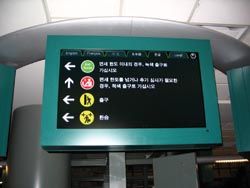- One of the main objections to digital signage, particularly portrait-mounted displays, is the cost to produce custom content on a continuous basis. Aurora Multimedia's DIDO Jr. allows standard content to be used in non-standard ways. Its patent-pending technology allows for real-time image rotation and rotated video walls, enabling random and creative monitor orientation.As customers grow more cognizant of the capabilities and potential of digital signage, the demand for more streamlined networking and better-tailored content is on the rise. In train stations, airports, sports and entertainment complexes and retail outlets, clients want technology that not only informs and/or advertises to their target demographics: they're starting to push for interactivity.
- "The application and the category that is driving the bus right now is ad-supported media networks," said Brad Gleeson, vice president of business development at Planar, referring to 'out-of-home' media networks comprised of advertising that exists outside of traditional media, such as television, radio and print. "The reason that digital signage exists is because the traditional media-television, print, and radio-are no longer working. Those things are not as effective in terms of consumer-packaged goods, so companies are reaching out for different ways to address their audience." To illustrate this concept, Gleeson cited a Planar customer in India, which rolled out a campaign whereby passersby could download coupons or information on various sales via text messaging.
- Gleeson notes that the flexibility that digital signage now offers enables end-users to capitalize on their original investment. For example, a coffee shop with a digital signage system can sell ads to neighboring boutiques. "If I run a laundromat, I can put a small advertisement on the plasma display in the coffee shop across the street to advertise a special," he illustrated. "What this will lead to is a consolidation and creation of an uber network, where you have the ability of an end-user to buy a display and plug it into a network, and then dial into one of these network feeds. They can display advertising from the network, as well as create their own."
- As sophisticated as clients may want to get, Maria Porco, vice president of business development at X2O Media, underlines that they still require a fair amount of guidance. "Customers need someone who is going to hold their hand through the process of designing and implementing this network," she said. Contractors should inquire on the basics: What will be shown on the network? How often will it be updated? "They can be very high level, general questions, but it helps the customer better understand what they need to do."
- Porco observes that there exists an imbalance of attention paid to certain aspects of digital signage technology. "There is a lot of time spent on the hardware," she said. "That is important, but there isn't much thought given to the content. We think that should be inverted, because if you are not paying as much attention, if not more, to the content as you are to everything else, then your network in the long run will not succeed."
- Content and content management go hand-in-hand, and as networks expand, how content is distributed and managed becomes crucial. "There is a lot more emphasis being put on not only the creative side of content these days, but how to get that content out to the actual screens: distribution, management, creation and play list management," said Richard F. Trask, director of public relations at Scala. Content must be carefully mapped out during an installation in order to fulfill both creative and managerial goals.
- Trask uses Scala's InfoChannel 5 Content Manager application as an example: "For example: for this installation, over the next week I would like to run this play list in this time frame, this play list in this time frame, and between two and three o'clock, I want to run a promotion for one of my products. You can plan that over a period of time-whether it is a week, a month or even a year," he explained. "Then you have a content management system built into your digital signage network that manages that entire process for you."
- Under this model, customers are not only able to push content from Point A to Point B; they are able to automate their scheduling. Trask concluded, "In digital signage today, and managing large, sophisticated networks, you need to be able to manage and plan where that content is going to play, when and how, and in conjunction with other content that is playing at the same time."
As Canada's second busiest airport, the Vancouver International Airport (YVR) employs the latest technology, and offers more than 160 shops, services, and restaurants to provide first class customer service to passengers and airport visitors. In recent years, the Airport Authority felt a growing need to enhance its dynamic content by including operational messages in multiple languages, TV programming, video, and weather.

The Vancouver International Airport uses Omnivex Display management software to make facility maps, directional instructions, and baggage claim information show in the language appropriate to the current flight schedule.
After reviewing other digital signage software on the market, YVR chose Omnivex Display management software. Omnivex worked with the Vancouver Airport Authority's IT department to determine the goals of the digital signage system and outline the solutions Omnivex could offer them.
The content is shown on a variety of displays including LCD, plasma, and LED boards. Using Omnivex DataPipe and SQLLink software, YVR is able to interface with its existing flight information database as a content source and as a means of triggering the appropriate content to be displayed.
A key feature of this deployment is that all of the facility maps, directional instructions, and baggage claim information is shown in the language appropriate to the current flight schedule. For example, if the flight is arriving from Hong Kong, information is shown in English and Chinese. With Omnivex DataPipe software, these changes take place automatically. In addition, the customs and immigration area features a large, full-colour LED board that welcomes passengers and displays messages in multiple languages to aid the customs process.










